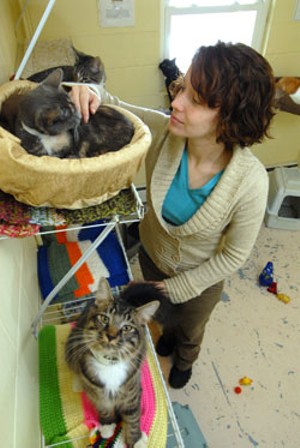Published March 11, 2009 at 10:21 a.m.
Anne Ross went to PetSmart in Williston the other day and asked for some free cat litter. It wasn’t for her own felines but for residents of the Central Vermont Humane Society, an animal shelter the 25-year-old has managed for two years.
Ross’ unprecedented request made perfect sense: Her Barre shelter’s stash of holiday donations is drying up just as animal relinquishments become more frequent, and adoption clients more rare. Shelter staffers are stretching budgets and working harder, Ross reports. Even so, needy pets-in-limbo aren’t receiving the same attention they would in healthier financial times.
That’s a typical story, says Joanne Bourbeau, president of the Waterbury-based Vermont Humane Federation. According to Bourbeau, who lobbies for 10 of the state’s 22 animal shelters, reps from those nonprofits tell her they are struggling to care for an increasing number of relinquished animals. Since most shelters rely on grants and private donations, she adds, “We’re not going to get any bailout money.”
On a recent Friday morning at CVHS, Ross stands in a room with a dozen-odd adoptable cats. The room smells of feces and disinfectant. Ross, whose white sweater and electric blue T-shirt match the shelter’s décor, explains that the animals were given up by clients who are dealing with evictions, unplanned moves, and other housing and financial crises.
Ross climbs the stairs to her cramped second-floor office. As she answers questions, cats meow incessantly from a nearby room. Ross says the relinquishment crunch started last fall, when she noticed that more clients than usual were giving up their domestic animals. In January and February, CVHS accepted double the number of cats and dogs it did during the same period last year.
In Ross’ view, media hype about the economy may be encouraging people to abandon animals. But she says watching so many homeless creatures arrive at her shelter also makes her wonder: Oh, my God, what is going on?
SEVEN DAYS: What are your daily tasks?
ANNE ROSS: I oversee the staff. Part of it is keeping an eye on the flow of animals. I also run the foster-care program, and I support the staff on the different projects they work with.
SD: Have you worked at other shelters?
AR: I worked at San Bernardino City Animal Control, in Southern California, and I’ve interned at Best Friends Animal Society [in Utah] and Farm Sanctuary in Watkins Glen, New York.
SD: What was San Bernardino like?
AR: It was absolutely huge. I don’t know what their intake was, but I think they had 600 animals on site at a time, and a 96 percent euthanasia rate. It was just horrific: something that you can’t imagine until you’re there.
SD: What’s the euthanasia rate at this shelter?
AR: It’s a different way of measuring. In San Bernardino, those animals aren’t tested; it’s entirely [for] space. Here, we make health and behavioral decisions — we wouldn’t adopt a hugely aggressive dog. We euthanized a very, very tiny percentage of animals last year for space: It was a lot less than 1 percent.
SD: How do you process incoming animals?
AR: There are different ways of animal sheltering. One is having a scheduled process, and I know there are several facilities in Vermont doing that. Our shelter is more geared toward open admission, but we beg and plead with people to please allow us to schedule, so that we don’t have to make space-based [euthanasia] decisions. People are generally very good about that, and if they’re not, they usually have a really good reason.
We try not to book more than a week or two out. Once you’ve made that decision, it’s pretty devastating, and to have that animal in your home is hard. This service has to be accessible to them. We hope a certain number [of animals] will be adopted. And we cross our fingers that, when we schedule two dogs for the end of the week, we’ll have adopted out two other dogs. One thing that is going to be changing: In the course of taking in more and more animals like we are, we’re about to launch a big campaign to increase our foster-care program.
SD: How will the situation at this shelter change in the coming months?
AR: It’s very frightening. Cats are pregnant right now, and that means, in a month or so, we’re going to start getting slammed with kittens. And then cats come out of the woodwork in the summer.
SD: At what point will you turn cats away?
AR: We don’t: That’s what distinguishes us from other organizations. We feel very strongly that, if there’s a need for a cat to come here, choosing to euthanize another animal to make space for that animal is better than closing our doors and saying, “Good luck,” and [having] people leaving cats in the woods. We think a shelter is the best place for an animal. It does make our decisions more difficult, but we don’t stop taking animals.
SD: Are you developing other strategies to weather the recent influx of animal relinquishments?
AR: The Agway in Montpelier and [Hillside Florist & Gifts] in Waterbury have cats available for adoption. We have cats full-time at PetSmart ... We also want to increase our presence at adopt-athons and go to farmers markets.


















































